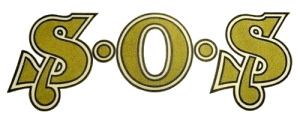


Leonard "Leslie" Hubert Vale-Onslow y sus motocicletas SOS
Las motocicletas SOS fueron producidas desde 1927 hasta 1939 por Len Vale-Onslow, quien primero construyó las unidades en Hallow, cerca de Worcester, antes de trasladar la producción a Birmingham en 1932 y, finalmente, pasar la firma al control de Tommy Meeten, un famoso ex piloto del TT y competidor en los ISDT (Trial Internacional de Seis Días) quien además había establecido una serie de récords mundiales y de resistencia con motores de dos tiempos en el famoso circuito de Brooklands. Desde ese año, Len comenzó a concentrarse en la reparación y venta de motocicletas y repuestos, firma que aún continua en el negocio y en la que el propio Lennie trabajó hasta el final de sus días. Condujo por primera vez una motocicleta en 1908 a los ocho años de edad y lo siguió haciendo hasta pasados los 100 años de edad. Por sus servicios para el mundo del motociclismo, Len Vale-Onslow fue distinguido como MBE (Miembro de la Orden del Imperio Británico) en 1995. Murió en 2004, días antes de cumplir los104 años.
En 1927 y debido a la falta de suministro de gas por cañerías en Hallow (lo que hacía difícil o casi imposible el empipado del cuadro por cobresoldadura), Len Vale-Onslow hizo sus primeras motos utilizando soldadura eléctrica para los cuadros. La soldadura por lo general tenía problemas de agrietamiento, por lo que fue a visitar a Accles & Pollock, un fabricante de acero y finalmente comprobaron que los caños de cromo molibdeno demostraron ser resistentes a agrietarse. Este método es el que la mayoría de las fábricas todavía utilizan para hacer las motos de hoy.
Las motocicletas fueron bautizadas como Super Onslow Especial y utilizaron las siglas en el slogan "So Obviously Superior" (Tan evidentemente superior). La mayoría tenía motores Villiers, pero algunos de los primeros modelos tenían motores JAP SV y OHV. En 1930 utiliza por última vez los motores JAP en los modelos OHV de 250 cc y 350 cc. A partir de entonces usa unidades Villiers de 172 cc a 343 cc. Todos los modelos estaban bien hechos y con muy buena terminación.
En 1933 aparece el primero de los modelos refrigerados por agua, basado en motores Villiers de 148 cc y 172 cc provistos de un cilindro SOS además de un radiador Serk. A finales del año se añadió un modelo refrigerado por agua de 249 cc. Ese mismo año el control de la firma es pasado a Tommy Meeten.
1939 fue el último año en el mercado puesto que las motocicletas no fueron construidas después del final de la guerra debido al saqueo de partes de stock y la destrucción de la fábrica.
Las SOS dos tiempos refrigeradas por agua fueron en gran medida conocidas por participar, con mucho éxito, en todas las formas de competencia de motocicletas, de allí que se la conociera también con el slogan "So Often Successful" (Tan a menudo exitosa)
Una de las máquinas especiales de la compañía de Birmingham fue el Modelo KW "Brooklands". Equipada para uso en ruta, también fue construida por encargo para competición. El Modelo KW era caro (£ 36 15s 0d) y utilizaba un motor SOS "Brooklands" de 172 cc (57mm x 67mm) - en realidad, una base Villiers con la famosa tapa y cilindro refrigerado por agua SOS y con un radiador y escapes elevados, junto con una caja de cambios Burman 250, una corta distancia entre ejes, cuadro liviano soldado y grandes frenos.

SOS motorcycles were produced from 1927 to 1939 by Len Vale-Onslow, who built his first machines in Hallow, near Worcester, before moving production to Birmingham and finally passing the company into the hands of Tommy Meeten, a famous rider who had competed in the TT and the International Six Day Trial (ISDT), and who had also established a series of world speed and endurance records on two-stroke motorcycles at the Brooklands circuit.
From that year, Leslie (more commonly Len or Lennie) began to concentrate on the repair and sale of motorcycles and parts, a firm that still continues in the business and in which Lennie himself worked until the end of his days - he was the oldest working man in Britain at the turn of the 20th century. He rode a motorcycle for the first time in 1908 at the age of eight (and got booked), and had his first accident that same year when he crashed an aeroplane which his brothers built. He was unconscious for some days. Unphased, he continued riding for over 90 years, having his last outing at the age of 102. For his services to the world of motorcycling, in 1995 Len Vale-Onslow was awarded the MBE.
Chrome-Moly
In 1927 there was no town gas in Hallow, making it nigh on impossible to construct a frame by brazing. Len Vale-Onslow made his first frames using electric welding, a method which in those times resulted in a product prone to cracking. He visited Accles & Pollock, a steel manufacturer, and after some haggling with government authorities as sales of the material were restricted, bought chrome molybdenum tubing which proved resistant to fatique - this technique was widely adopted and used in the manufacture of such household names as the Manx Norton. It is still in use by most factories to this day.
The motorcycles were baptized as Super Onslow Special and used the acronym in the slogan "So Obviously Superior". Most had Villiers engines, but some of the early models had JAP SV and OHV engines, the last of the JAP-powered machine leaving the factory in 1930 with 250cc and 350cc OHV engines. Thereafter, all machines had Villiers two-strokes of 172 cc to 343 cc. The motorcycles were all well-engineered with a very good finish.
The first water-cooled models appeared in 1933, based on 148 cc and 172 cc Villiers engines fitted with an SOS cylinder and radiator. At the end of the year, a 249 cc water-cooled model was added.
That same year S.O.S. manufacturing rights were sold to Tommy Meeten, leaving Vale-Onslow to concentrate on the retail side.
In 1934 the range expanded to include both air-cooled and water-cooled machines of 172cc to 346cc, some with weather protection in the form of leg-shields and deeply valanced mudguards. At this point some models were named, for example the Magnetic and the Thunderbolt. By 1936 Meetens Motorcycle Mecca had opened, acting as main retail outlet for the well-finished S.O.S. motorcycles.
S.O.S.
A RANGE of attractive S.O.S. two-strokes is shown at the Olympia Motor Company's garage at 16, Avonmore Road, London, W.15 (almost opposite the Hammersmith Road entrance to Olympia). The neat water-cooled models are of particular interest to two-stroke enthusiasts—especially the 249 c.c. “E.W. Superb.” This model has specially strengthened leg and under shields.
In the air-cooled range there are machines of 172 c.c., 249 c.c. and 346 c.c. —all with Villiers engines. Two further models are fitted with the 249 c.c. flat-top piston Villiers engine.
Altogether there are ten different models available.
The 1935 Olympia Show reported in The Motor Cycle, December 5th, 1935.
The SOS water-cooled two-strokes were familiar faces in all forms of motorcycle competition, and another of their slogans was "So Often Successful". The 250 was widely regarded as one of the best two-strokes available.
One of the special machines of the Birmingham company was the Model KW "Brooklands". Equipped for road use, it was also built on commission for privateers. The KW model was expensive (£36 15s 0d) and it used an SOS "Brooklands" 172 cc (57mm x 67mm) engine - a Villiers bottom-end with an SOS water cooled cylinder, a radiator and high exhaust, along with a Burman gearbox, a short wheelbase, lightweight welded frame and large brakes.
1939 was the last year of production. During the war the factory was destroyed, and the remaining stock was looted.
In those terrible years Vale-Onslow remained busy as always, and bought up the stock of dealers going out of business, filling his storerooms at 98-116 Stratford Road, Sparkbrook, Birmingham, a process he continued after the war. He attempted to obtain a licence to build the BSA Bantam when BSA ended production in early 60's, but that came to naught as BSA's management had rather cleverly destroyed the tooling. In later years he restored classic motorcycles, using the vast amount of stock he had built up over the years. At the age of 99 he stated that he planned to ride his S.O.S. motorcycle to Buckingham Palace to receive his 100th birthday greetings from the Queen.
Len Vale-Onslow died in 2004, days before his 104th birthday. Such was the regard for this great man that the busy main road was closed as the funeral procession, which included over 100 motorcycles, filed past his premises. At the service they played "Born to be Wild".
Sources: Sergio Scalerandi, independent.co.uk, BBC, The Motor Cycle, et al.
If you have a query or information about about this subject please contact us